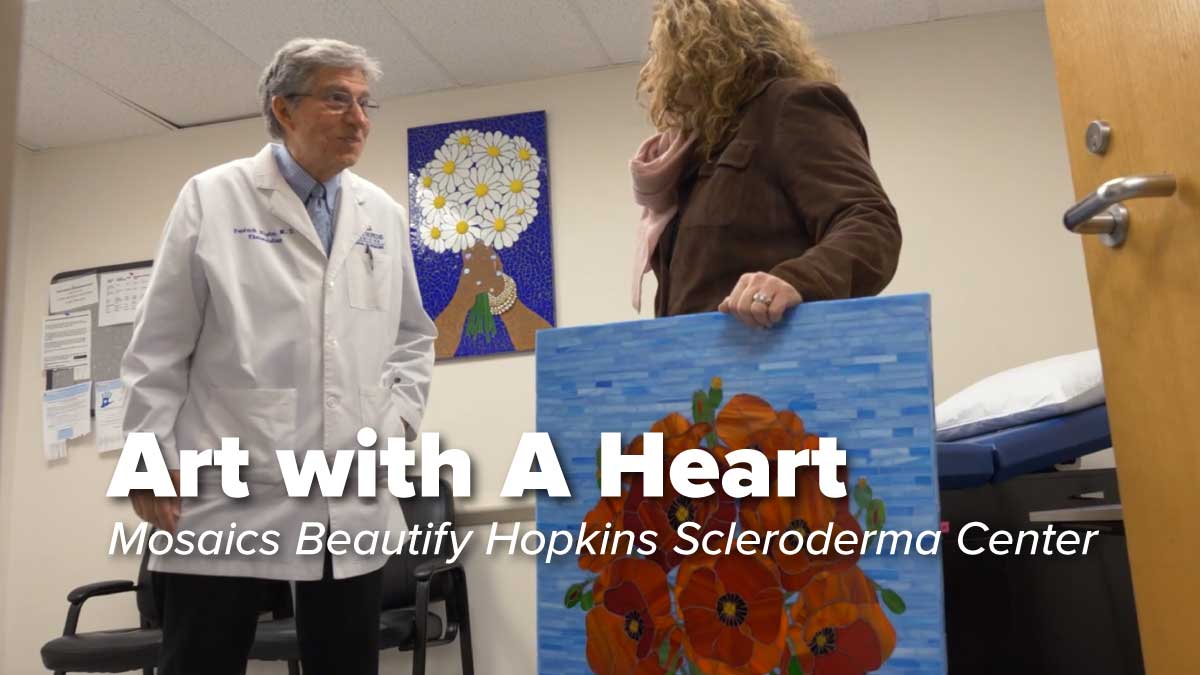Ami Shah, associate professor in the Division of Rheumatology, was named a 2020 recipient of the Henry Kunkel Young Investigator Award from the American College of Rheumatology (ACR). This award honors an early career physician scientist, who is 12 years post rheumatology certifying examination eligibility, who has made outstanding and promising independent contributions to basic, translational or clinical research in the field of rheumatology. This is a very prestigious award given to her by her peers for her important discovery of the link between cancer and scleroderma and her current expertise in research related to scleroderma. She was recognized at this year’s virtual ACR Convergence meeting.
News from the Johns Hopkins Scleroderma Center
Original art given to beautify Scleroderma Center

Patient Randi Pupkin leads effort to create nine mosaics
As the founder and executive director of Art with a Heart, Randi Pupkin has dedicated her career to enhancing the lives of people in need through visual art.
The non-profit organization has many areas of impact, from teaching art classes in schools, shelters, and community centers; to arts-related youth programs and jobs training; a retail art store; and the creation of large-scale, public art installations around Baltimore City.
Pupkin’s most recent project hits even closer to her heart: beautifying the Johns Hopkins Scleroderma Center by working with her team of staff and volunteers to create nine mosaics, one for each treatment room.
“They’re all going to include hands and flowers because hands are the number one, telltale sign with scleroderma,” according to Pupkin, who was diagnosed with the disease in 2013.
Scleroderma is a rare autoimmune disease where the body produces too much collagen that hardens and stiffens different areas in the body, including the skin.
“It can affect other systems such as the heart, the lung, the GI track, even the kidney,” says Frederick Wigley, MD, the director of the center. “Without treatment, it’s a multi-system disease that can shorten one’s life unfortunately.”
During her treatment of immune-suppressing drugs, a secondary infection led to Pupkin’s own lung capacity diminishing to 63%, before her health eventually took an upturn.
“The good response to medication, the positive outcome, and, frankly, recovery that she’s had has inspired her to help others to understand that when this disease hits them, it’s not inevitably a downhill outcome,” Wigley says. “So, like the mosaic, it’s a positive spin on a tough situation.”
“We just wanted it to say something beautiful to the people who are waiting in each of these treatment rooms,” says Pupkin, adding the materials for the mosaics were donated by the family of fellow patient Judy Kolker, in her memory.
“And the treatment I got from Dr. Wigley and Johns Hopkins – you can’t compare it to anything,” Pupkin says. “Dr. Wigley is the most stellar human being and the best physician I’ve ever known in my life. I’m humbled by him.”
“I’ve been put on this earth to cure scleroderma,” says Wigley, adding because it’s an uncommon disease it can be more difficult to secure the research funds essential for discovering new treatments and an ultimate cure.


